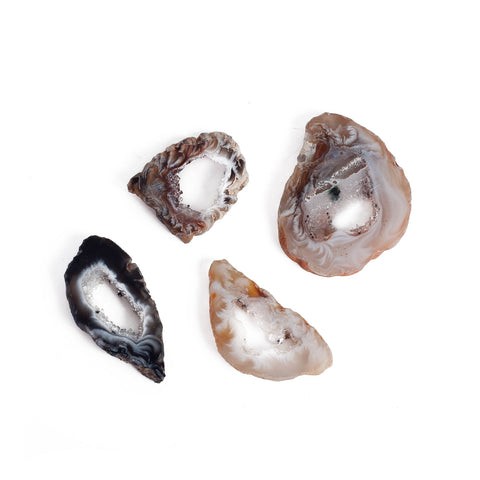Geodes, those unassuming rocks that reveal breathtaking crystal interiors, have captivated collectors and enthusiasts for ages. Their allure lies in the unexpected beauty hidden within, making them popular decorative items and prized additions to mineral collections. But How Much Are Geodes Worth? Let’s delve into the factors that determine their value and explore the fascinating world of these geological treasures.
Understanding Geode Value: More Than Just Rocks
The worth of a geode isn’t simply based on its size or weight. It’s a combination of factors, including rarity, the aesthetic appeal of the crystal formations inside, and the geode’s overall uniqueness. This means a seemingly plain geode could be hiding a valuable secret, while a larger one might be less desirable due to imperfections or common crystal types.
Key Factors Influencing Geode Value
Several crucial elements contribute to a geode’s market value. Understanding these factors will help you assess the potential worth of your own geodes or make informed decisions when purchasing.
Crystal Formation Quality: The Inner Beauty
The quality of the crystal formation within a geode is paramount. Well-formed, lustrous crystals in rare colors command higher prices. Factors like crystal size, clarity, and the presence of unique formations like stalactites or unusual mineral inclusions significantly impact value. A geode filled with sparkling amethyst crystals will generally be worth more than one with dull, poorly formed quartz crystals.
Size and Weight: Bigger Isn’t Always Better
While size can play a role, it’s not the sole determinant of value. A larger geode with unremarkable crystal formations might be worth less than a smaller geode boasting exceptional quality. However, all else being equal, a larger geode with desirable crystals will typically fetch a higher price.
Location of Origin: Rarity and Reputation
The geographic origin of a geode can also influence its value. Certain locations are known for producing geodes with specific, highly sought-after minerals or unique formations. For instance, geodes from Morocco are often prized for their vibrant colors and unique crystal structures. Similarly, geodes from certain regions of Mexico are known for their exceptional amethyst or agate formations. Rarity also comes into play; if a particular location no longer produces geodes, existing specimens may increase in value.
Geode Type and Mineral Composition
The type of minerals found inside a geode greatly affects its value. Common minerals like quartz are less valuable than rarer minerals like amethyst, celestite, or calcite with unusual formations. The presence of multiple minerals within a single geode can also increase its desirability.
How Much Are Geodes Really Worth? Price Ranges and Examples
The price of a geode can vary dramatically, ranging from a few dollars to thousands. Small, common geodes with basic quartz crystals might sell for as little as $5 to $20. On the other hand, large, museum-quality geodes with rare minerals and exceptional crystal formations can command prices exceeding $1,000.
Here’s a general guideline:
- Small, common geodes (under 5 inches): $5 – $20
- Medium-sized geodes with attractive quartz or calcite crystals (5-10 inches): $20 – $100
- Large geodes with unusual mineral formations or vibrant colors (over 10 inches): $100 – $1,000+
- Exceptional, museum-quality geodes with rare minerals and unique formations: $1,000+
The Impact of Being Cut Open:
A geode that has been expertly cut open to reveal its inner beauty often commands a higher price than an uncut one. The act of revealing the crystals allows potential buyers to fully appreciate their quality and aesthetics. However, the cutting must be done carefully to avoid damaging the crystals.
Determining the Value of Your Geode: A Step-by-Step Guide
If you’re curious about the value of a geode you own, here’s a process to help you estimate its worth:
- Identify the Minerals: Determine what minerals are present inside the geode. Use online resources, mineral identification guides, or consult with a geologist or gemologist.
- Assess the Crystal Quality: Evaluate the size, clarity, luster, and overall formation of the crystals.
- Research the Origin: If possible, determine where the geode was found. Knowledge of the origin can provide clues about the minerals likely to be present and their potential value.
- Compare to Online Marketplaces: Browse online marketplaces like eBay, Etsy, and specialized mineral websites to find similar geodes and compare their prices. Pay attention to the details mentioned above.
- Consult with Experts: Consider seeking the opinion of a qualified geologist, gemologist, or antique dealer specializing in minerals. They can provide a more accurate assessment of your geode’s value.
Geode Value FAQs: Addressing Common Questions
Q: Are all geodes worth something?
A: While all geodes are fascinating geological specimens, not all are valuable. Common geodes with low-quality crystals may have minimal monetary value.
Q: What makes a geode more valuable?
A: Rarity, crystal quality, size (to a degree), origin, and the presence of unusual mineral formations contribute to a geode’s value.
Q: Where can I sell my geode?
A: You can sell your geode online through platforms like eBay and Etsy, at gem and mineral shows, or through antique dealers and collectors.
Conclusion: Appreciating the Value of Geodes
The question of “how much are geodes worth” is multifaceted, with no single answer. By understanding the factors that influence their value, you can better appreciate these natural wonders and make informed decisions about collecting, buying, or selling them. Whether you’re drawn to their aesthetic beauty or fascinated by their geological origins, geodes offer a glimpse into the Earth’s hidden treasures, reminding us of the remarkable power and artistry of nature.

